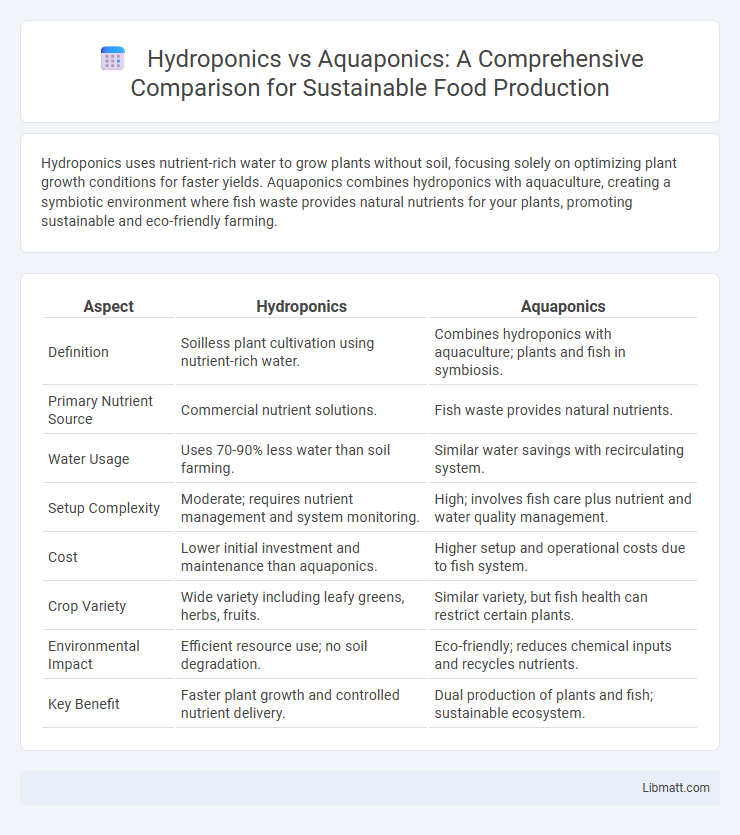Hydroponics uses nutrient-rich water to grow plants without soil, focusing solely on optimizing plant growth conditions for faster yields. Aquaponics combines hydroponics with aquaculture, creating a symbiotic environment where fish waste provides natural nutrients for your plants, promoting sustainable and eco-friendly farming.
Table of Comparison
| Aspect | Hydroponics | Aquaponics |
|---|---|---|
| Definition | Soilless plant cultivation using nutrient-rich water. | Combines hydroponics with aquaculture; plants and fish in symbiosis. |
| Primary Nutrient Source | Commercial nutrient solutions. | Fish waste provides natural nutrients. |
| Water Usage | Uses 70-90% less water than soil farming. | Similar water savings with recirculating system. |
| Setup Complexity | Moderate; requires nutrient management and system monitoring. | High; involves fish care plus nutrient and water quality management. |
| Cost | Lower initial investment and maintenance than aquaponics. | Higher setup and operational costs due to fish system. |
| Crop Variety | Wide variety including leafy greens, herbs, fruits. | Similar variety, but fish health can restrict certain plants. |
| Environmental Impact | Efficient resource use; no soil degradation. | Eco-friendly; reduces chemical inputs and recycles nutrients. |
| Key Benefit | Faster plant growth and controlled nutrient delivery. | Dual production of plants and fish; sustainable ecosystem. |
Introduction to Hydroponics and Aquaponics
Hydroponics is a soil-less cultivation technique where plants grow in nutrient-rich water solutions, enabling controlled and efficient growth. Aquaponics combines hydroponics with aquaculture, integrating fish farming and plant cultivation in a symbiotic system where fish waste provides natural nutrients for plants. Understanding these innovative methods can help you optimize space, conserve water, and enhance sustainable food production.
Core Principles: How Each System Works
Hydroponics relies on growing plants in nutrient-rich water solutions without soil, delivering essential minerals directly to roots for accelerated growth. Aquaponics combines hydroponics with aquaculture, using fish waste as a natural fertilizer that is converted by bacteria into nutrients for plants, while plants help purify the water for the fish. Both systems create highly efficient, soil-free ecosystems but differ fundamentally in nutrient source and biological interactions.
Key Components and Setup Requirements
Hydroponics relies on a nutrient-rich water solution and inert growing media such as coconut coir or perlite, requiring precise control of pH, electrical conductivity, and oxygen levels. Aquaponics combines hydroponic plant growth with aquaculture, involving fish tanks, biofilters, and a media bed where fish waste is converted into nutrients for plants, thus needing an integrated ecosystem balance. You must consider the complexity of system management, space requirements, and initial setup costs when choosing between these two sustainable farming methods.
Water Usage and Conservation
Hydroponics uses nutrient-rich water recirculated within a closed system, optimizing water efficiency by reducing waste and evaporation compared to traditional soil farming. Aquaponics combines fish farming with plant cultivation, where water is continuously recycled between fish tanks and grow beds, minimizing freshwater use while creating a self-sustaining ecosystem. Your choice between these systems can significantly impact water conservation efforts depending on the scale and specific water recycling techniques employed.
Nutrient Sources and Management
Hydroponics relies on a carefully balanced nutrient solution composed of essential minerals and elements to directly feed plants, allowing precise control over nutrient availability and concentration. Aquaponics integrates fish waste as a natural nutrient source, with beneficial bacteria converting ammonia into nitrates, creating a sustainable cycle that supports both aquatic animals and plants. Understanding these nutrient management differences helps optimize your system's efficiency and plant growth outcomes based on your resource preferences and maintenance capabilities.
Plant Growth Rates and Yields
Hydroponics systems typically deliver faster plant growth rates due to precise nutrient control and oxygenation, resulting in higher yields per square foot compared to traditional soil methods. Aquaponics combines fish farming and plant cultivation, providing a sustainable nutrient cycle from fish waste but sometimes slower growth rates due to fluctuating nutrient availability. Studies indicate hydroponics can increase yields by up to 25-30% faster than aquaponics under controlled conditions, while aquaponics offers long-term ecosystem benefits and resource efficiency.
Sustainability and Environmental Impact
Hydroponics uses nutrient-rich water solutions to grow plants without soil, significantly reducing water usage by up to 90% compared to traditional farming, making it highly sustainable. Aquaponics combines hydroponic plant cultivation with aquaculture, creating a symbiotic system where fish waste provides natural nutrients, minimizing chemical inputs and promoting circular resource use. Both methods enhance sustainable agriculture, but aquaponics offers greater biodiversity and efficient waste recycling, leading to lower environmental impact overall.
Cost Analysis and Initial Investment
Hydroponics typically requires a lower initial investment due to simpler system components like nutrient solutions and pumps, while aquaponics demands higher startup costs for fish tanks, filtration systems, and maintaining aquatic life. Operational costs in hydroponics mainly involve purchasing nutrients and electricity, whereas aquaponics incurs additional expenses for fish feed and water quality monitoring. You can reduce long-term expenses in aquaponics by harvesting both plants and fish, offering dual revenue streams unlike hydroponics focused solely on plant production.
Maintenance Demands and Challenges
Hydroponics requires regular monitoring of nutrient solutions and pH levels to prevent nutrient imbalances, demanding consistent attention to water quality and system cleanliness. Aquaponics combines fish care with plant cultivation, requiring knowledge of both aquatic animal health and biofiltration processes to maintain a balanced ecosystem. Your maintenance efforts in aquaponics increase due to the need for managing fish waste and ensuring adequate oxygenation, presenting unique challenges compared to the more controlled environment of hydroponics.
Which System Fits Your Needs?
Hydroponics and aquaponics each offer unique advantages depending on your goals and resources; hydroponics provides faster plant growth with precise nutrient control, making it ideal for growers seeking efficiency and simplicity. Aquaponics combines fish farming with plant cultivation, creating a sustainable ecosystem that benefits those interested in organic production and waste recycling. Your choice should align with your space availability, desired investment level, and whether you want to manage both plants and aquatic life.
Hydroponics vs Aquaponics Infographic

 libmatt.com
libmatt.com